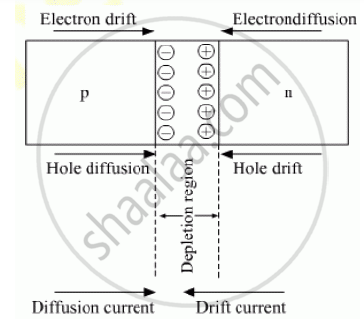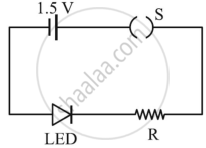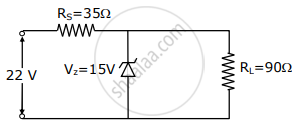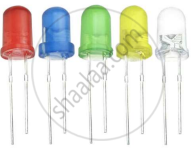Advertisements
Advertisements
प्रश्न
Describe briefly, with the help of a diagram, the role of the two important processes involved in the formation of a p-n junction ?
उत्तर
Two important process involved in the formation of a p-n junction are:
Diffusion and,
Drift
In n-type semiconductor electrons are the majority carriers and holes are minority carriers. In the same way, in p-type semiconductor holes are majority and electrons are minority carriers. During the formation of p-n junction, due to concentration gradient across p- and n-side, holes diffuses from p-side to n-side and electrons diffuses from n-side to p-side. This motion gives rise to diffusion current across the junction.
When an electron diffuses from n- to p-side, it leaves behind a positive charge. In such a manner a positively charged layer forms on n-side of the junction.
Similarly, when a hole diffuses from p- to n-side, it leaves behind a negative charge and a negatively charged layer forms on p-side of the junction.
This space-charge region is known as depletion legion. An electric field directed from positive charge towards negative charge develops. Due to this field, electrons on p-side of the junction move to n-side and holes on n-side of the junction move to p-side. This motion of charge carriers due to the electric field is called drift.
Drift current is opposite in direction to the diffusion current.

Initially, diffusion current is large and drift current is small. Space-charge region on either side increases as the diffusion process continues. This increases the electric field and hence the drift current. This process continues until the diffusion current equals the drift current. Thus a p-n junction is formed.
संबंधित प्रश्न
With the help of a neat circuit diagram, explain the working of a photodiode.
Describe, with the help of a circuit diagram, the working of a photodiode.
Briefly explain its working. Draw its V - I characteristics for two different intensities of illumination ?
Explain the formation of depletion layer and potential barrier in a p−n junction.
Draw the circuit arrangement for studying the V-I characteristics of a p-n junction diode in reverse bias. Plot the V-I characteristics in this case.
Draw the V-I characteristics of an LED. State two advantages of LED lamps over convertional incandescent lamps.
Answer the following question.
Explain the three processes involved in solar cell working.
Read the following paragraph and answer the questions.
|
LED is a heavily doped P-N junction which under forward bias emits spontaneous radiation. When it is forward-biased, due to recombination of holes and electrons at the junction, energy is released in the form of photons. In the case of Si and Ge diode, the energy released in recombination lies in the infrared region. LEDs that can emit red, yellow, orange, green and blue light are commercially available. The semiconductor used for fabrication of visible LEDs must at least have a band gap of 1.8 eV. The compound semiconductor Gallium Arsenide – Phosphide is used for making LEDs of different colours.
|
- Why are LEDs made of compound semiconductor and not of elemental semiconductors?
- What should be the order of bandgap of an LED, if it is required to emit light in the visible range?
- A student connects the blue coloured LED as shown in the figure. The LED did not glow when switch S is closed. Explain why?

OR
iii. Draw V-I characteristic of a p-n junction diode in
(i) forward bias and (ii) reverse bias
The value of power dissipated across the Zener diode (Vz = 15 V) connected in the circuit as shown in the figure is x × 10–1 watt. The value of x, to the nearest integer, is ______.

What energy conversion takes place in a solar cell?

